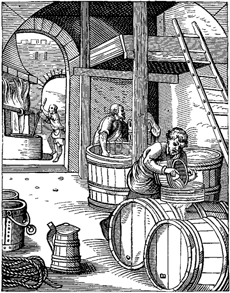The History Of Beer
|
If you love food, you may love learning more about it. Museums mount enlightening exhibits that put the history of our mainstay foods in perspective.
Take beer. The New York Historical Society has just opened an exhibit called Beer Here, Brewing New York’s History. Chock full of artifacts, the exhibit runs through September 2, 2012. At the conclusion of the exhibit, you step into a “tavern” to taste some outstanding craft beers from New York brewers. The selection varies daily. We happened to catch the new Small Batch IPA from Heartland Brewery, a brewpub with seven Manhattan locations. The IPA’s complex layering of herbal and floral flavors and aromas is simply thrilling. But you don’t have to be in Manhattan to find an exhibit on beer, hot dogs, tacos and other favorite foods. Check with your local museums, historical societies and academic institutions to see what they may be cooking up. |
 [1] An engraving of a 16th century brewery (image courtesy Wikipedia). |
|
|
THE IMPORTANCE OF BEER IN CITIES As cities grew and local water supplies became polluted, microbes in the water caused disease in the population. People could not safely consume water that had not been boiled. But beer making boils the water and kills the pathogens. Plus, in the 19th centuries it was discovered that the hops used to flavor beer had antipathogenic and preservative properties (and were even made into medicines). Beer was one of the most common beverages in the Middle Ages, consumed daily by all social classes in the northern and eastern parts of Europe. Beer also provided a considerable amount of the daily calorie intake. Until clean municipal water supplies were developed in the 19th century, even young children drank beer. In addition to serving as a vital source of nourishment, beer was a steady source of tax revenue. |
||
 [2] The Lightning closure was invented in the 1870s and is still in use today, upgraded with a ceramic cap and a rubber gasket. It’s called a swing top. Check out more historic bottle closures (photo © Society For Historical Archaeology). |
Beer Trivia
|
|
|
Thanks to the American Homebrewers Association for the beer trivia. As you enjoy a cold one, consider brewing your own. We really enjoyed making beer with a Mr. Beer kit. |
||